Tomato "Blue cluster f1": originality of shape and color
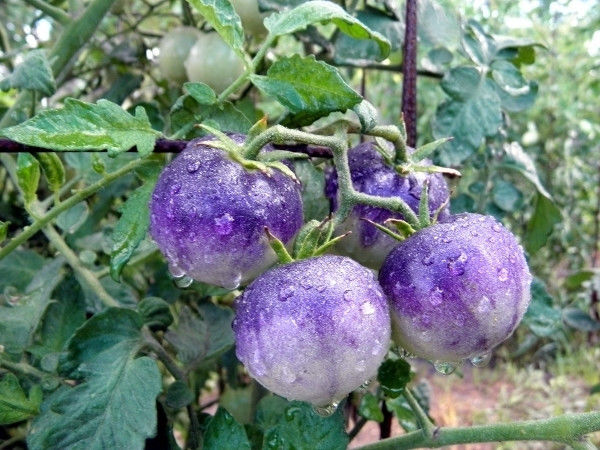
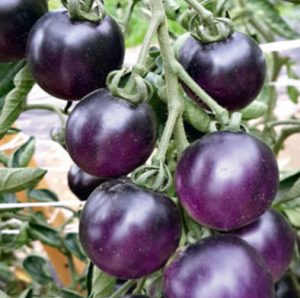 One of the most original novelties, which pleased the lovers of the exotic, is Blue Bunch F1 tomato, which, according to gardeners and photos, will make your loved ones and friends admire their extraordinary look.
One of the most original novelties, which pleased the lovers of the exotic, is Blue Bunch F1 tomato, which, according to gardeners and photos, will make your loved ones and friends admire their extraordinary look.
No plant lover can pass by this plant, their fruits are so unusual and beautiful. Clusters of blue-colored tomato resemble clusters of large grapes that seem unnatural and magical.
The variety is medium early, indeterminant type. Used for growing in greenhouses and in the open field, resistant to temperature extremes and diseases of tomatoes.
Since many summer residents show interest in the Blue Cluster, here are the well-known characteristics and description of the variety.
The main thing about tomato
The shrubs of the plant with a powerful stem, tall, reach 1.5 m, the leaves are low-pubescent, bright green. It is usually formed in 1-2 stems, especially when grown in closed ground.
Small fruits have features:
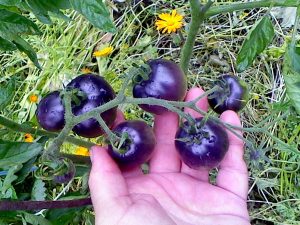
- The shape is round - about 5 cm in diameter.
- The color is dark purple, almost blue.
- Pulp juicy with very pleasant original taste.
- The skin is dense.
- Weight tomato - 20-25g.
- Use fresh and for canning - they look very nice in banks.
See also: Tomato Black Elephant: very tasty, unpretentious and fruitful
Pests and diseases
Like many other hybrids, the plant is resistant to most diseases of tomatoes. However, since there is a possibility of infection, it is necessary to provide preventive measures for treatment against viral and fungal diseases:
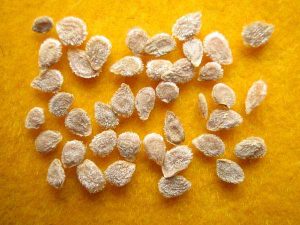
- Treat seeds in disinfectant solutions before planting.
- Comply with the rules of crop rotation - planted in areas where tomatoes, potatoes or other nightshade have not grown in the past three years.
- When growing plants in a greenhouse, it is necessary to process the greenhouse itself and the ground inside it.
- During the entire growing season, spraying with phytosporin, treatment with copper oxyfluoride or Bordeaux mixture with the likelihood of late blight.
The main pests of tomatoes - slugs, whitefly, spider mite, Colorado potato beetle - inhibit foliage and can be detected by careful inspection of plants. Against them there are a large number of drugs.
In small areas, gardeners consider it safer to sprinkle with decoctions of wormwood, dandelion, ash, or simply wash the leaves with a solution of household soap. Colorado beetles and slugs can be harvested by hand, and one cannot be late with this procedure, since the larvae cause much more harm than the beetles themselves.
What is interesting hybrid
Tomato Blue cluster is so interested, according to reviews of vegetable growers with their photos, that many did not notice other merits that prompted them to plant it on their plot.
The advantages of tomato include:
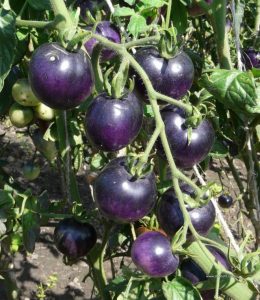
- Unusual, original fruit flavor.
- High immunity to diseases.
- The original appearance of brushes with blue plum-like tomatoes.
- Versatility of use.
- Productivity - up to 6 kg per sq. M.
- Fruits are a kind of pharmacy: they contain a large amount of antioxidants necessary for cleansing the body, and the presence in them of a special substance - anthocyanin, improves the immune system.
- Eating fruits increases resistance to cancer and diseases of the cardiovascular system.
Many vegetable growers consider the need for increased attention and care for the plant - the formation, thinning of leaves, pasynkovaniya to the disadvantages of the variety; therefore, they prefer not to grow Blue Bunch tomato on their plots, despite the fact that it is very attractive according to the description.
See also: Why do green tomatoes rot in the bushes in the greenhouse, and how to save the crop?
Features of tomato cultivation
The timing of sowing seeds on seedlings depends on the place of cultivation of tomato. If you plan to plant in the greenhouse, then begin to engage in sowing in mid-March, so that by the time of planting seedlings her age was about two months. To grow tomatoes without shelter, sowing is done in early April.
One of the observed features of a tomato, according to reviews, is the low germination of seeds. To improve the germination and cultivation of high-quality seedlings, take care of seed treatment before sowing:
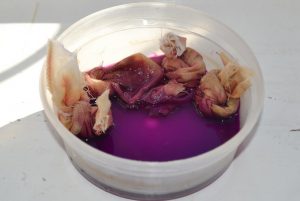
- Use for disinfection of seeds before sowing 1% solution of potassium permanganate, keeping seeds in it for 20 minutes. Phytosporin can also be used for seed disinfection.
- Treat the seeds before planting with growth stimulants such as Zircon, Appin, which promote faster seed germination. Exposure time in solutions - 5-6 hours.
- Treat the seeds with micronutrients that trade offers for this purpose.
The treated seeds are placed in the moistened earth with an interval of 1.5 -2 cm, covered with earth (about 5 mm) and slightly compacted. The boxes are covered with thick paper or film, leaving small holes and cleaned for several days in a warm (22-25 degrees) place.
The temperature regime following two shoots after sprouting is kept quite hard - at night 13-14 degrees., In the afternoon -15-16 degrees., Then the temperature is raised to 20-22 degrees. Watering is carried out as the soil dries, in any case not watering the ground.
In the phase of several true leaves, usually at the age of 4-5 weeks, the seedlings dive into cups or boxes of larger volume, planting them every 15-20 cm.
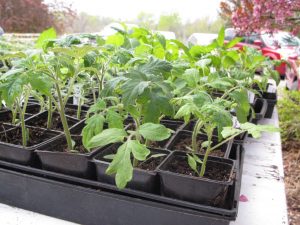 During the whole time of growing seedlings, it is kept in a well-lit place, watered, fed, as needed. By the time of planting, the plants should have 5-6 true leaves, a strong stalk, a well-developed root system.
During the whole time of growing seedlings, it is kept in a well-lit place, watered, fed, as needed. By the time of planting, the plants should have 5-6 true leaves, a strong stalk, a well-developed root system.
By planting seedlings begin when the earth warms up and comes a steady heat. Plants are planted in the ground prepared in the fall. Holes are made at a distance of 50-60 cm between plants and 70 cm between rows. When planting in the greenhouse, the distance between the holes increases.
Compost or rotted manure, ash, mineral fertilizers are brought into the recesses, the earth is moistened, and after planting it is watered again.
Plant care includes the usual activities: watering every 7-10 days depending on the weather, weeding, feeding with an interval of two to three weeks - first with nitrogen fertilizers - mullein solution or herb extract, when the plants begin to bloom massively, add phosphorus and potash fertilizers.
See also: The most fruitful, sweet varieties of tomato
Creating comfortable conditions for the plant, care, the correct formation of the bushes in 1-2 stems, will allow you to get beautiful memorable in taste and appearance of the fruits of this exotic plant.
Video: Caring for tomatoes. First important steps



 (7 ratings, average: 3,29 from 5)
(7 ratings, average: 3,29 from 5)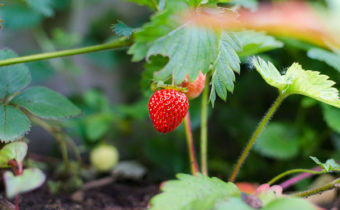
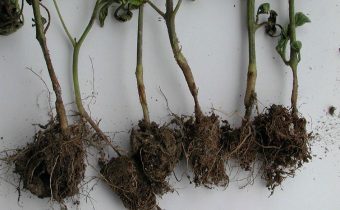
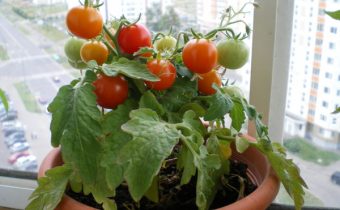
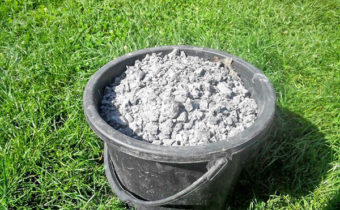
Marina
Sort Blue bunch awesome tomato. very tasty. Seeds ascended amicably and quickly. The only drawback for me is very tall bushes. because this variety refers to cherry. Tomatoes are beautiful, only paint brushes to paint, delicious. And so care is the same as for all other tomatoes.